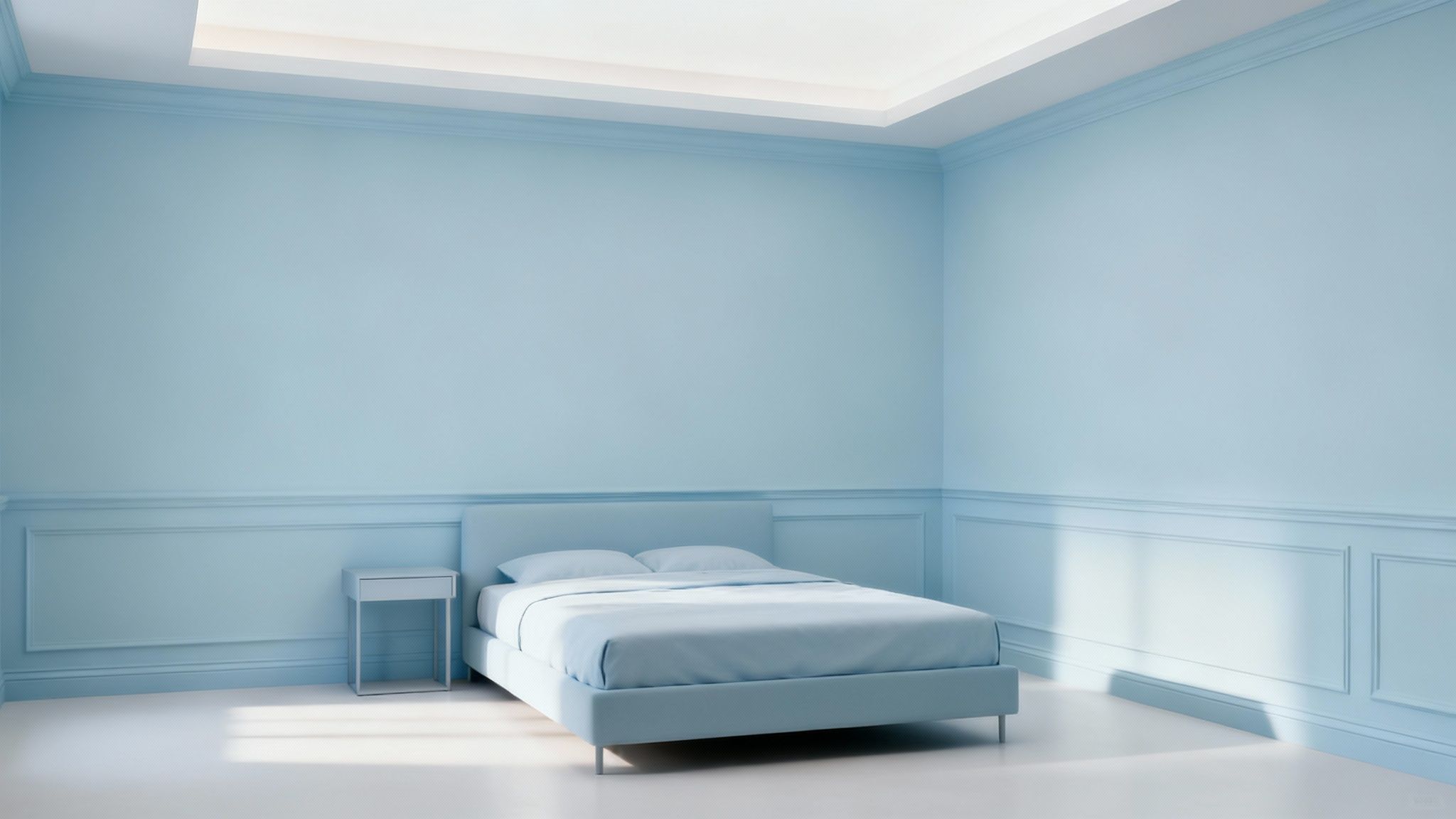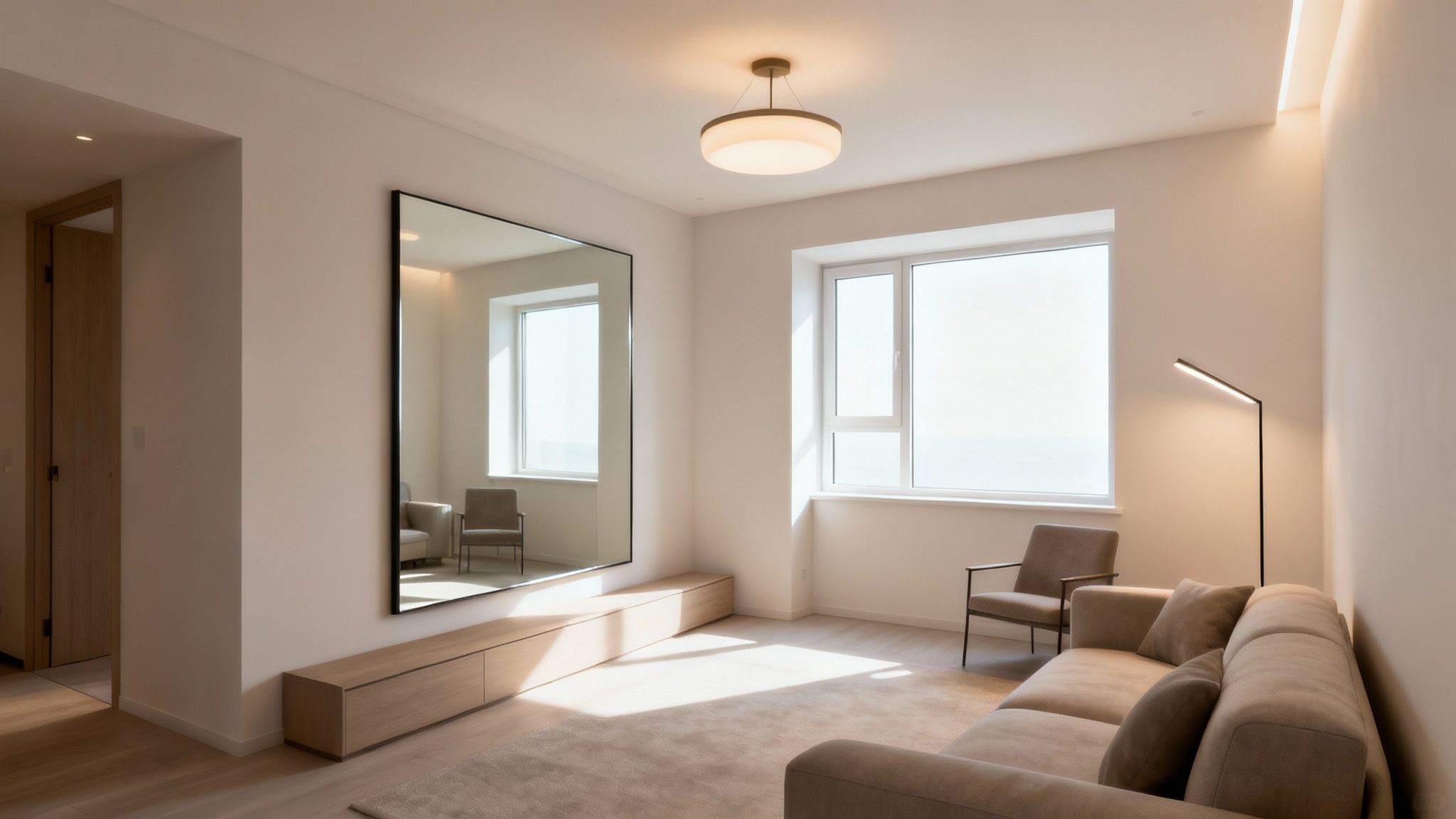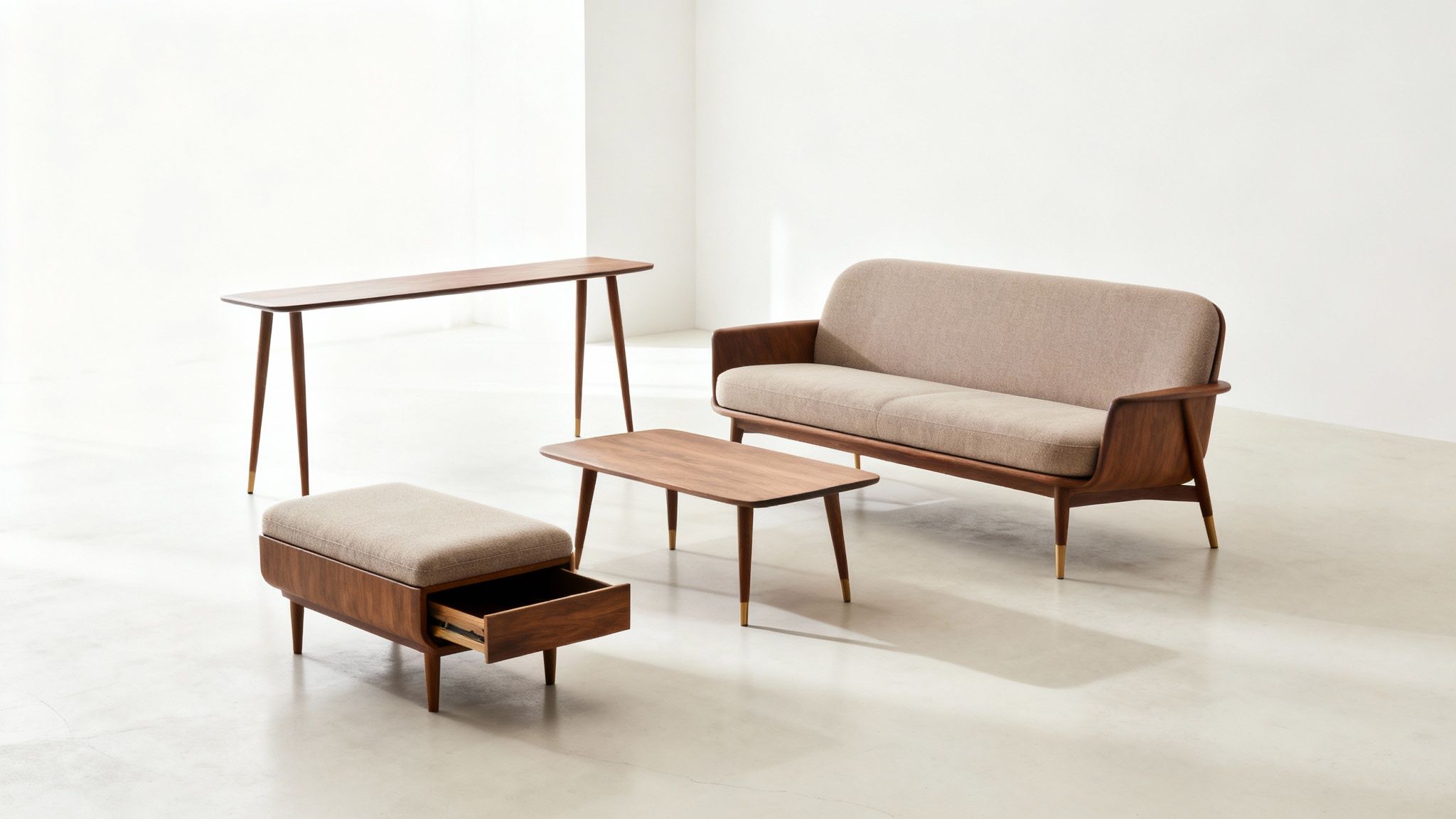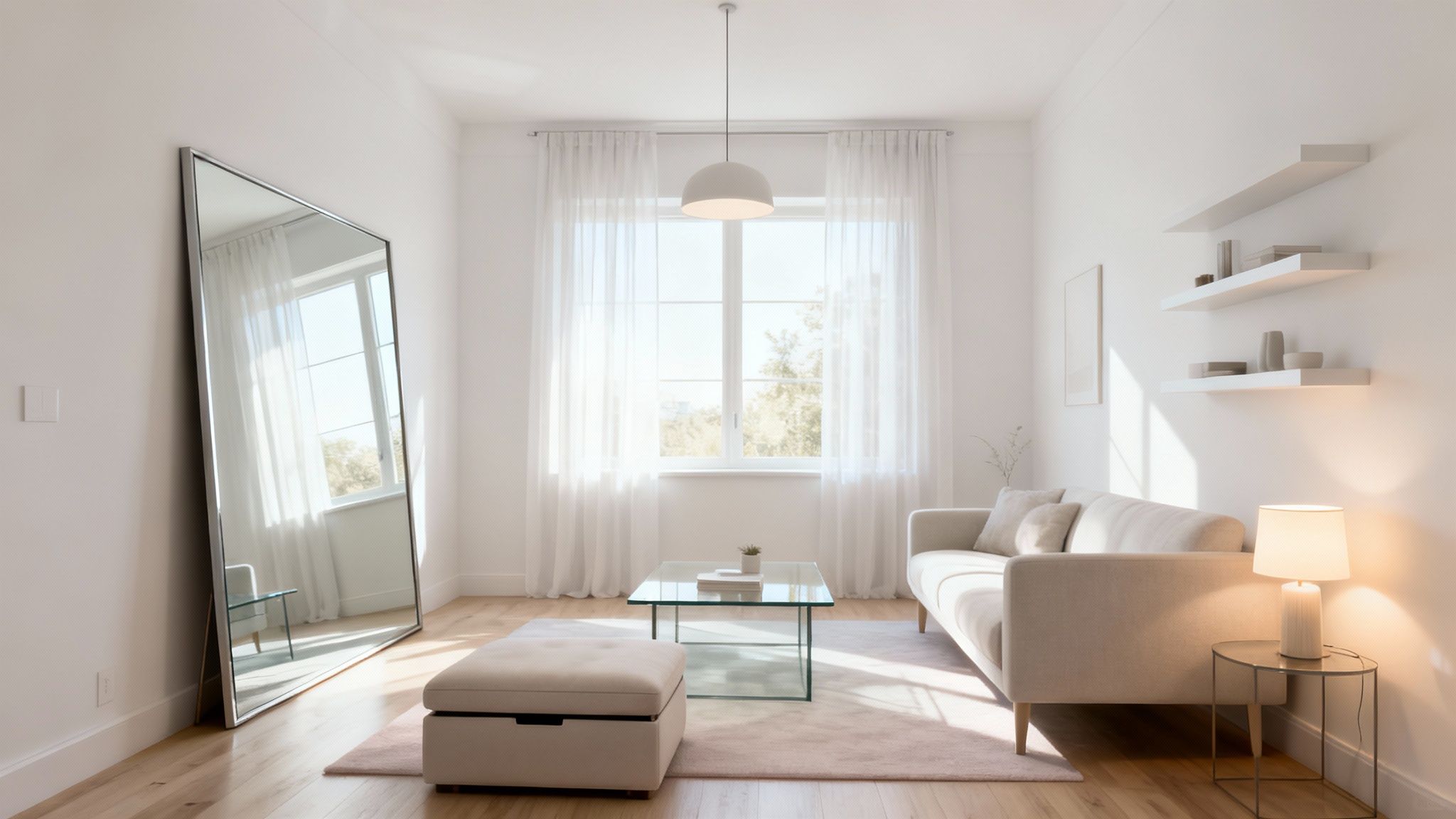When you're trying to make a small room feel bigger, it all comes down to mastering three key things: light, colour, and furniture scale. Get these right, and you can trick the eye into seeing a space that feels open, airy, and far more inviting than its actual square footage suggests.
The Foundation: How to Create the Illusion of Space
That feeling of being boxed in is something most of us have dealt with. The good news is you don't need a sledgehammer to fix it. Making a small room look bigger is less about construction and more about clever design psychology. It's all about manipulating perception.
Thoughtful choices in your colour palette, lighting plan, and furniture layout can make a space feel worlds away from cramped. The aim is to blur the room's edges, drawing your gaze upwards and outwards to create a sense of expansion. This guide will walk you through the core strategies that every successful small-space design is built on.
The Three Pillars of a Bigger-Feeling Room
Before we get into specific tricks, let's nail down the foundational concepts. Think of these as the unbreakable rules that will guide every other decision you make.
Embrace the Light: Nothing makes a room feel larger than bright, even light. Your top priority should be to amplify every bit of natural light you have and then supplement it strategically with artificial sources to banish gloomy corners.
Create a Cohesive Colour Story: A unified colour palette, especially one built on lighter shades, is a game-changer. When your walls, skirting boards, and even the ceiling are painted in similar tones, the boundaries of the room seem to dissolve, making it feel more expansive.
Choose Furniture That Fits: Every piece you bring into a room affects its perceived size. Selecting furniture with the right proportions and a slim profile is crucial. It's all about maintaining clear, walkable pathways to avoid that cluttered, hemmed-in feeling. For a deeper dive, check out our guide on small living room layout ideas for some practical setups.
The secret isn't about owning less stuff. It's about making every single item in the room work harder to create that illusion of space. From the sheen of your paint to the style of your sofa's legs, every detail counts.
Once you get a handle on these core ideas, you'll have the framework to apply all the other tips and tricks that follow, ensuring your small room doesn't just look bigger, but feels beautifully calm and organised too.
Here's a quick summary of these foundational strategies and what they achieve.
Core Strategies for Visually Enlarging a Room
This table breaks down the most effective techniques and their impact on making a space feel larger.
By keeping these core principles in mind, you're setting yourself up for success as you start to implement more specific changes.
Using Paint and Colour to Create an Illusion of Space
When you’re trying to make a small room feel bigger, paint is easily your most powerful and budget-friendly tool. The right colour choices can completely transform how you perceive a space, making it feel brighter, taller, and so much more open. And you can forget the old rule that you have to stick to brilliant white; there are far more sophisticated ways to trick the eye these days.
The best place to start is with a cohesive, light-reflecting colour palette. Think soft neutrals, muted pastels, and gentle off-whites. These shades are fantastic because they bounce light around the room, which helps to blur the hard corners and edges. This creates a seamless, airy feeling that stops the space from feeling cramped or boxed in.

Embrace Monochromatic and Colour Drenching
One of the most effective strategies is adopting a monochromatic scheme. Now, this doesn't mean painting everything the exact same shade. It’s more about layering different tones of a single colour to build depth and interest without creating the kind of visual clutter that shrinks a room. If you're looking for a bit more guidance, our journal has some great advice on how to choose paint colours that will work together beautifully.
A brilliant evolution of this idea is colour drenching. This is a technique where you paint the walls, skirting boards, window frames, and even the ceiling in the same gorgeous shade. By doing this, you erase the lines that usually define the room's boundaries, creating an uninterrupted flow that makes the space feel almost boundless. Interior designers love this method for giving small rooms a unified, cohesive look that tricks the eye into seeing more depth. You can discover more insights about small space design trends on House Beautiful to see it in action.
Creative Paint Techniques to Add Height
It's not just about the colour itself, but how you apply it. Here are a few clever techniques to create an illusion of more space:
Paint the Ceiling a Lighter Shade: A classic for a reason. Simply choosing a colour for your ceiling that's a few shades lighter than the walls instantly draws the eye upward, giving the impression of a higher ceiling.
Use a Satin or Eggshell Finish: Matte finishes are lovely, but a paint with a subtle sheen, like satin or eggshell, will gently reflect light. This little bit of reflection helps brighten the space and contributes to a more open feel without looking too glossy.
Vertical Stripes for Height: If you're feeling a bit more adventurous, subtle, low-contrast vertical stripes on a feature wall can work wonders. This timeless trick guides the eye up and down, visually stretching the walls and making the room feel taller.
The real secret is to create a soft, unified canvas where the room’s boundaries aren't so obvious. By using colour to blur the lines between walls, ceiling, and trim, you can achieve that sophisticated, expansive feel, no matter how small your room actually is.
Mastering Light and Mirrors to Add Depth and Brightness
Beyond the colour on your walls, the way a room is lit has a massive impact on how spacious it feels. Dark, shadowy corners are the enemy; they visually shrink a space and make it feel cramped. The real secret to making a small room look bigger is to think about your lighting in layers, making sure every part of the room is washed in a warm, welcoming glow.
A single, harsh overhead light just won't cut it. In fact, it often does more harm than good by creating stark shadows. A truly well-lit room is a blend of different light sources working together to create a balanced, airy atmosphere.

The Three Layers of Effective Lighting
To get that bright, open feel, it's best to incorporate three distinct types of lighting. Each layer has a specific job, and when you combine them, you completely banish those gloomy spots that make a room feel boxy.
Ambient Lighting: This is your foundation—the room's main light source that provides general illumination. This could be a central pendant light, recessed spotlights, or another ceiling fixture that casts a wide, even light.
Task Lighting: Think of this as focused, practical light for specific activities like reading, cooking, or working. Good examples include a table lamp on a side table, a floor lamp tucked beside an armchair, or under-cabinet strips in the kitchen.
Accent Lighting: This is the fun part. You use accent lighting to highlight features you love, like a piece of art, a textured wall, or a cool architectural detail. Picture lights or adjustable spotlights are perfect for adding this layer of depth and interest.
By weaving these layers together, you draw the eye around the room and create a much more dynamic and bright environment. We dive even deeper into this layered approach in our guide on how to brighten a dark room, which is packed with more handy tips.
The Transformative Power of Mirrors
Mirrors are one of the oldest tricks in the book for a reason—they work! They are absolute masters of illusion, practically doubling the perceived size of a room by bouncing light and reflecting views.
A strategically placed mirror does more than just show your reflection; it acts like an extra window, bouncing natural light into the darkest corners and creating a profound sense of depth.
Placement is everything. The most powerful move you can make is to hang a large mirror directly opposite a window. It will literally grab the daylight and the view from outside and throw it back into the space, making the whole room feel instantly brighter and bigger.
Don't be timid here. A single, large statement mirror will have a much more dramatic effect than a cluster of small ones, which can end up looking cluttered. Even something as simple as a full-length mirror leaned against a wall can create a wonderful illusion of height and space with a relaxed, casual feel.
Choosing Furniture That Creates Openness
Once you’ve nailed the colour palette and lighting, your next big mission is choosing furniture that actually works with the room, not against it. The right pieces can create a real sense of openness and flow, but the wrong ones can make even the cleverest paint job feel pointless. It’s all about being clever with scale, style, and function.
The single most effective trick is to pick furniture with visible, slender legs. Think sofas on elegant tapered feet or console tables that look light and airy. This simple design choice lets you see the floor underneath, which stops the furniture from looking like a heavy, solid block. When your eye can travel under a piece, it creates a powerful illusion of more floor space – an absolute game-changer in a small room.

Getting the Scale and Proportion Just Right
One of the biggest mistakes people make is cramming a small room with lots of tiny furniture. It seems logical, but it almost always backfires, creating a cluttered, doll's house effect that shrinks the space. Instead, it’s far better to choose a few key pieces that are scaled properly for the room.
A single, well-proportioned sofa, for example, will look much more sophisticated and spacious than a jumble of mismatched little chairs. You're looking for that "Goldilocks" balance. Steer clear of anything overly bulky or ornate that will just dominate the view. A sofa with low, slim arms has a much less imposing profile than one with high, rolled arms. Getting the scale and placement right is everything, and you can dive deeper with our guide on how to arrange furniture in a living room.
The goal is to furnish the room, not fill it. Every piece needs a bit of breathing room. That negative space is just as important as the furniture itself for creating a calm, uncluttered feel.
Embrace Multifunctional and Smart Furniture
In a compact home, every piece of furniture needs to earn its place. This is where multifunctional items become your secret weapon. Picking pieces that offer hidden storage or serve a dual purpose is one of the smartest ways to reclaim your square footage.
This isn't just a niche idea; it’s a full-blown trend. Flexible furniture is now a key strategy for making small rooms look bigger. There's been a huge surge in demand for things like foldable desks and modular sofas. More and more homeowners are making sure they have at least one piece of multifunctional furniture to keep their home adaptable and use every inch of space wisely. You can discover more insights about these interior design trends on Refresh Renovations.
Here are a few hardworking heroes to consider:
- Storage Ottoman: A stylish ottoman can be a coffee table, extra seating, and a place to hide blankets or magazines.
- Nesting Tables: These are brilliant. Use them when you need them, then tuck them away to free up the floor.
- Extendable Dining Table: Perfect for small dining nooks, letting you host guests without permanently sacrificing your space.
By making these clever furniture choices, you’ll end up with a room that’s not just organised and functional, but feels significantly more spacious and inviting.
7. Master the Art of Textiles and Décor
This is where you get to inject your personality into a room, but for smaller spaces, every choice needs to be strategic. The wrong rug or overly fussy curtains can instantly make a room feel cramped and boxed in. When you're smart about your décor, however, each item can work for you, building an open, airy atmosphere instead of taking away from it.
One of the oldest and best tricks in the book involves your windows. Don't just place the curtain rod right above the window frame. Instead, hang it as high as you possibly can—we're talking just a few inches below the ceiling or crown moulding. Make sure the rod extends wider than the frame, too. It’s a simple fix that creates the illusion of a much taller, grander window, which in turn makes the whole wall feel more expansive.

Unify the Floor with the Right Rug
When dealing with a small floor plan, your first instinct might be to use a few small rugs to create different "zones." Unfortunately, this usually backfires, chopping up the floor visually and making the entire space feel disjointed and even smaller.
A much better approach is to go for one large, light-coloured rug. A single, substantial rug that can sit under the front legs of your main furniture pieces creates a clean, cohesive foundation. This visual continuity makes the floor feel like one seamless surface, stretching the perceived boundaries of the room. If you do love a more layered look, you can learn more about combining floor coverings in our guide on how to layer rugs.
The key is to think bigger, not smaller. A few well-chosen, larger-scale decorative items will create a greater sense of space than a collection of small, scattered knick-knacks, which can quickly read as clutter.
Embrace a "Less Is More" Approach
Ultimately, decorating a small space is an exercise in careful curation. Every single item needs to earn its spot, whether it's functional, beautiful, or (ideally) both. Before you bring anything new into the room, stop and ask yourself: will this enhance the feeling of openness, or will it just add to the noise?
Here are a few quick rules of thumb to follow:
- Go Big with Art: One large piece of statement art has far more impact than a gallery wall of tiny frames. It gives the eye a single, strong focal point and stops the wall from looking busy.
- Keep Patterns Simple: If you can't live without patterns, stick to simple, large-scale designs. Small, intricate prints can feel chaotic in a compact room. Tone-on-tone textures are also a fantastic way to add depth without visual clutter.
- Clear the Surfaces: Get ruthless with clutter. Find a proper home for everything and aim to keep surfaces as clear as possible. An organised space always feels like a more spacious one.
By being intentional with your finishing touches, you can bring in plenty of warmth and character without sacrificing that all-important sense of space.
Common Questions About Maximizing Small Spaces
https://www.youtube.com/embed/mv_kQsPXw0U
Even with a solid game plan, putting these ideas into practice in your own home can throw up a few curveballs. Let's tackle some of the most frequently asked questions about making a small room feel more spacious.
Does Dark Paint Always Make a Room Look Smaller?
Surprisingly, no. While it’s true that light colours are a safe bet for bouncing light around, a dark, moody shade can sometimes work magic in the right setting.
Think about a room that doesn’t get much natural light to begin with. A deep, dramatic colour in a satin or eggshell finish can actually blur the room's corners and edges. This creates a cosy, seemingly infinite space that feels sophisticated, not cramped.
Should All My Furniture Match in a Small Room?
Absolutely not! In fact, a perfectly matched furniture set can feel bulky and a bit old-fashioned, visually weighing down the room.
A much better approach is to curate individual pieces that complement each other in style or colour palette. You can create a real sense of openness by mixing materials and visual weights. For instance, pairing a solid, comfy sofa with a transparent glass or acrylic coffee table keeps the sightlines clear and the space feeling airy.
One of the biggest mistakes is filling a small space with tiny furniture. It sounds counterintuitive, but a few well-chosen, appropriately scaled pieces make a room feel far larger and less cluttered than a dozen small, scattered items. This gives the room a cleaner, more intentional look and allows the space to breathe.




